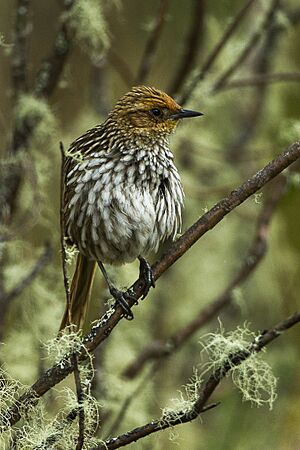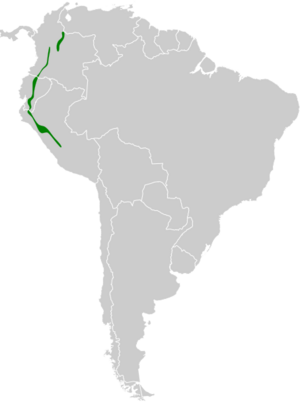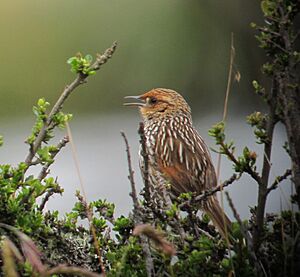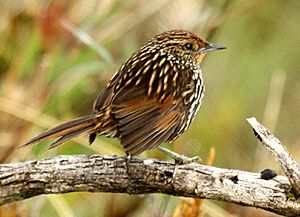Many-striped canastero facts for kids
Quick facts for kids Many-striped canastero |
|
|---|---|
 |
|
| Conservation status | |
| Scientific classification | |
| Genus: |
Asthenes
|
| Species: |
flammulata
|
| Subspecies | |
|
See text |
|
 |
|
The many-striped canastero (Asthenes flammulata) is a cool passerine bird that belongs to the ovenbird family called Furnariidae. You can find this bird in the high mountains of Colombia, Ecuador, and Peru. It's known for its bold stripes, which help it blend in with its grassy home.
Contents
About Its Name and Family
Scientists give every living thing a special name. The many-striped canastero got its first official name, Synalaxis flammulatus, from a scientist named William Jardine way back in 1850. He found a sample of the bird near Quito.
Today, most bird experts agree that there are five slightly different types, or subspecies, of the many-striped canastero. These are like different versions of the same bird, each living in a specific area:
- A. f. multostriata
- A. f. quindiana
- A. f. flammulata
- A. f. pallida
- A. f. taczanowskii
Some scientists group A. f. pallida together with A. f. taczanowskii. Other birds, like the Junin canastero and scribble-tailed canastero, were once thought to be subspecies of the many-striped canastero. However, genetic tests show they are actually separate but closely related species.
What It Looks Like
The many-striped canastero is a medium-sized bird, about 16 to 17 cm (6.3 to 6.7 in) long. It weighs between 17 to 27 g (0.60 to 0.95 oz), which is about as much as a few quarters. Both male and female birds look the same.
This bird is famous for its stripes! It has a light, buff-white stripe above its eye. Its face is dark brownish with lighter streaks. The top of its head is a bright reddish-brown with dark brown stripes. Its back is dark brown with clear, pale buff stripes.
Its wings are dark brown with reddish-brown edges. The tail feathers are narrow and look a bit spiny, with dark brown on the inside and reddish-brown on the outside.
The chin and upper throat are a bright orange-buff color, which becomes duller lower down. Its chest and sides are whitish with strong dark brown stripes. These stripes become lighter and less noticeable on its belly. The lower sides and under its tail are reddish-brown with faint streaks. Its eyes are brown, its beak is dark, and its legs and feet are brownish or greenish-gray.
Young canasteros have a fainter throat patch and less clear stripes than adult birds.
Subspecies Differences
The different subspecies have slight variations in their colors and markings:
- A. f. multostriata has a more yellowish stripe above its eye, a darker reddish-brown forehead, and a deeper reddish-orange chin and throat. Its stripes on the sides and under the tail are wider and darker.
- A. f. quindiana is similar to multostriata but has a white chin, a paler throat, and narrower stripes under its tail.
- A. f. taczanowskii has a pale buff or off-white throat and narrower stripes on its back. The stripes on its underside are mostly on the chest and sides, while its belly and under the tail are plain grayish-white.
- A. f. pallida is like taczanowskii but has slightly wider stripes on its back and a yellowish-orange tint on its throat and neck.
This bird can sometimes be confused with the streak-backed canastero or the Andean tit-spinetail, but the many-striped canastero has much bolder markings.
Where It Lives and Its Home
The many-striped canastero lives in different, separate areas. The five subspecies are found in these regions:
- A. f. multostriata: In Colombia's Eastern Andes mountains, between the departments of Norte de Santander and Cundinamarca.
- A. f. quindiana: In Colombia's Central Andes mountains, between the departments of Caldas and Cauca.
- A. f. flammulata: From Nariño Department in Colombia's Western Andes mountains, south through Ecuador, and into northern Peru's Department of Cajamarca.
- A. f. pallida: In the Andes mountains of northern Peru, in the Cajamarca and La Libertad departments.
- A. f. taczanowskii: In the Andes mountains of northern and central Peru, from southern Amazonas and Cajamarca departments south to Ancash and Junín departments.
This bird likes to live in the area where the forest ends and the páramo grasslands begin. This habitat often has rocky areas, scattered shrubs, Espeletia plants, and groups of Polylepis trees. It usually lives at high elevations, mostly between 3,000 and 4,500 m (9,800 and 14,800 ft) (about 9,800 to 14,800 feet), but sometimes as low as 2,700 m (8,900 ft) (about 8,900 feet) in Colombia.
Behavior
General Behavior
The many-striped canastero is often described as a bit shy and likes to stay hidden. It hops and runs among clumps of grass, sometimes holding its tail up high. If the weather is calm, it might perch on a grass clump or shrub for a few minutes.
Movement
This bird does not migrate. It stays in the same area all year round.
Feeding
The many-striped canastero eats arthropods, which are creatures like insects and spiders. It usually looks for food alone or in pairs. It finds its prey mostly by picking it off the ground, but also from shrubs and Polylepis tree branches.
Reproduction
Scientists do not know much about how the many-striped canastero reproduces or raises its young.
Vocalization
The song of the many-striped canastero is a series of buzzing notes that get faster and higher in pitch at first. Then, it smoothly changes into a stuttering, descending trill that sounds like tzee-tzee-tzee-tzeetzeetzetztztztzrrrrrrr. It usually sings from a perch on top of a shrub. Sometimes, two birds will sing back and forth to each other. The song is quite similar among all the different subspecies.
When it feels disturbed, the bird makes a sad, nasal sound like eeuw or mew. It also has a short, high-pitched pit note that it uses as an alarm call.
Status
The IUCN (International Union for Conservation of Nature) has evaluated the many-striped canastero and listed it as a species of "Least Concern." This means that, for now, it is not considered to be in danger of extinction.
Even though it has a very large range, scientists don't know the exact size of its population or if its numbers are increasing or decreasing. No immediate threats have been found for this bird. It is thought to be uncommon in the southern parts of its range and fairly common in the northern parts, but it is not well-studied anywhere.
It is believed that too much grazing by animals could harm this bird's habitat. However, occasional controlled burning of the páramo grasslands can actually help it. The many-striped canastero lives in at least two protected areas in Ecuador, which helps keep its habitat safe.




